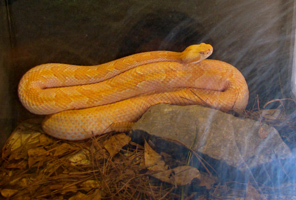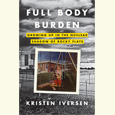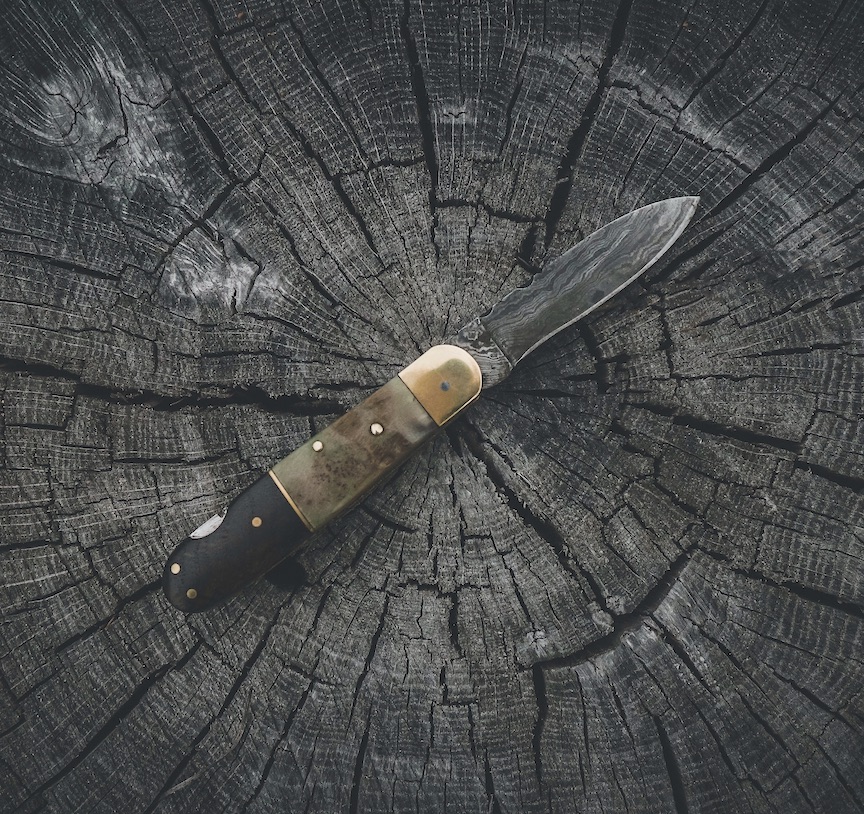Kingsnakes and Beauty Queens
At the Rattlesnake Festival in Claxton, Georgia, a writer confronts her lifelong fear
In Richard Avedon’s photograph of Boyd Fortin, the thirteen-year-old holds up a rattlesnake’s partially disemboweled carcass, the creature’s organs spread like a clothesline across a once-white apron. Avedon photographed Fortin in Sweetwater, Texas, at the annual rattlesnake roundup, an event that celebrated its fifty-fifth year last March. At these roundups, wranglers capture thousands of rattlers and bring them to an arena where they are brandished, mutilated, milked, sold, slaughtered, and skinned. Shortly after I moved to Atlanta in 2012, someone informed me that Georgia still hosts a yearly roundup, too. “They even crown a beauty-pageant queen,” I was told. “She kills the first snake.”
 I started an electronic file called “Roundup Research,” but it contains only one document: a link to a CNN video about Sweetwater, which does indeed show pageant contestants. The 2011 winner of the Miss Snakecharmer contest, Laney Wallace, remarks, “Tomorrow I get to skin snakes and chop their heads off, and I’m super excited about it.” In another scene, a man squeezes a decapitated snake until its blood drips into a young lady’s upturned palms. She turns to a white wall to leave her handprints. That macabre ritual did it for me: A roundup was not in my future.
I started an electronic file called “Roundup Research,” but it contains only one document: a link to a CNN video about Sweetwater, which does indeed show pageant contestants. The 2011 winner of the Miss Snakecharmer contest, Laney Wallace, remarks, “Tomorrow I get to skin snakes and chop their heads off, and I’m super excited about it.” In another scene, a man squeezes a decapitated snake until its blood drips into a young lady’s upturned palms. She turns to a white wall to leave her handprints. That macabre ritual did it for me: A roundup was not in my future.
Something about the events still preoccupied me, though, perhaps because I had always assumed Avedon’s photograph belonged to a time long past, a historical document of a bleaker era. I’m still not sure what I hoped to find at the 2013 Rattlesnake and Wildlife Festival, but it was only a three-hour drive away in Claxton, Georgia, and I talked my friend Kristen into going with me.
Until 2011, this festival was also a roundup, but the Claxton Chamber of Commerce—responding to concerns from groups such as One More Generation and the Georgia Department of Natural Resources—turned it into an appreciation weekend. By the time Kristen and I got there, few remnants of the festival’s gory past remained, but one booth did display an array of animal pelts for children to stroke. And I nearly bumped into a pen of cottonmouths while I was trying to snap a photo of tiara-wearing girls posing with a diamondback. Mostly, though, the event was an excuse for families to enjoy a warm spring day and eat fair food. Kristen and I snacked on tater tots and fried pickles and looked for the conservation booths.
.jpg) The best of these was The Orianne Society, a non-profit founded in 2008 to save the threatened eastern indigo and its ecosystem. I chatted with my first herpetologist as he gently maneuvered a Central American indigo for a small crowd. Another scientist approached to show me a scarlet kingsnake, a slim species that grows to only a foot or two in length. “She just shed her skin,” the handler said. “That’s why she’s so glossy.” And she was. Her black stripes were iridescent, and I almost wanted to touch them. I surprised myself by admiring what had most scared me as a child. Was this what I had hoped to find?
The best of these was The Orianne Society, a non-profit founded in 2008 to save the threatened eastern indigo and its ecosystem. I chatted with my first herpetologist as he gently maneuvered a Central American indigo for a small crowd. Another scientist approached to show me a scarlet kingsnake, a slim species that grows to only a foot or two in length. “She just shed her skin,” the handler said. “That’s why she’s so glossy.” And she was. Her black stripes were iridescent, and I almost wanted to touch them. I surprised myself by admiring what had most scared me as a child. Was this what I had hoped to find?
When my family first moved into the house I still think of as home in Wartrace, Tennessee, snakes were a problem. The previous owners hadn’t taken very good care of the property, and small critters had no trouble finding their way indoors. Our four acres of land were also infested with a wide variety of venomous and non-venomous slitherers, many of which my father and uncles killed, sometimes with guns and hoes, sometimes with tractors, sending pieces flying into the brush. Even with all this—even after years had passed—snakes still found us. They sunned themselves in our driveway, hid in the hedges, and once climbed up our fireplace mantel. My mother, father, brother, and I all developed a fear of being taken by surprise. In Claxton, though, watching the kingsnake glint in the afternoon light, my only sensation was wonder.
 The highlight of the second annual Rattlesnake and Wildlife Festival had nothing to do with snakes. It was a raptor demonstration led by Steven Hein of the Center for Wildlife Education at Georgia Southern University. The hawks, falcons, and owls ate out of Hein’s hand and swooped over the crowd of attentive listeners. The message was simple: with contact comes understanding. Hein wants people, particularly children, to have first-hand experiences with wildlife. I can’t say that my childhood experiences with snakes gave me much admiration for the animals, but I understood his point.
The highlight of the second annual Rattlesnake and Wildlife Festival had nothing to do with snakes. It was a raptor demonstration led by Steven Hein of the Center for Wildlife Education at Georgia Southern University. The hawks, falcons, and owls ate out of Hein’s hand and swooped over the crowd of attentive listeners. The message was simple: with contact comes understanding. Hein wants people, particularly children, to have first-hand experiences with wildlife. I can’t say that my childhood experiences with snakes gave me much admiration for the animals, but I understood his point.
Despite my countless run-ins with snakes, I have never been bitten, and neither has anyone in my family. And yet we’ve killed dozens of snakes. While I’m not sure what else could have been done about the unidentified specimen that was once making its way to our pet bird—and my bedroom—our actions now struck me as unfair. Maybe what I wanted from the festival was an understanding of change, evidence that a roundup can become an appreciation festival and still gather crowds.
In trying to find more information about Boyd Fortin, I stumbled across a documentary about Avedon from PBS’s American Masters series. In the first five minutes, Avedon confesses, “I think I have photographed what I was afraid of.” And a few minutes later: “By photographing what I was afraid of, I explored and learned and laid the ghost.” When I flip through my own snapshots, I’m amazed anew by how beautiful that kingsnake is, how docile the eastern indigo, and even how bold the diamondback. The festival may have been partly an excuse to sell crafts and fried foods, but I did gain a new appreciation for both rattlesnakes and wildlife.
 On the drive back to Atlanta, Kristen and I passed the time with the Proust Questionnaire on the back page of Vanity Fair and then wrote twenty questions of our own. “How would you least like to die” was at the top of our list. “Being impaled,” Kristen answered without hesitation, describing semi-trucks carrying steel beams, the way they could crash through a windshield into her torso. I took a minute to consider. In the past, my answer would have been snake-related, perhaps that scene from Raiders of the Lost Ark when Indiana Jones is dropped into the pit. As a kid, I never made it past that point in the movie.
On the drive back to Atlanta, Kristen and I passed the time with the Proust Questionnaire on the back page of Vanity Fair and then wrote twenty questions of our own. “How would you least like to die” was at the top of our list. “Being impaled,” Kristen answered without hesitation, describing semi-trucks carrying steel beams, the way they could crash through a windshield into her torso. I took a minute to consider. In the past, my answer would have been snake-related, perhaps that scene from Raiders of the Lost Ark when Indiana Jones is dropped into the pit. As a kid, I never made it past that point in the movie.
I still don’t wish to be lowered into the middle of a rattlesnake roundup arena, but when I think of those roundup pens—thousands of creatures with no hope of escape—I feel more sadness than terror. At the end of the day, I realized, human beings are the most dangerous animal, and we should take responsibility for our outsized fears. The first step might be finding a way to admire what frightens us in nature.
“Rotting,” I finally answered.
“We’re all rotting,” Kristen said.
“Like gangrene,” I clarified.
Is there a festival for that?
Copyright (c) 2014 by Erica Wright. All rights reserved.


